Welcome back to This Week in Apps — the easiest way to keep up with everything that happened in the world of apps over the past week — from the breaking news to the trends and all the other information an industry watcher needs to know.
The app industry is as hot as ever, with 194 billion downloads in 2018 and more than $100 billion in consumer spending. People spend 90% of their mobile time in apps and more time using their mobile devices than watching TV. In other words, apps aren’t just a way to waste idle hours — they’re big business, and one that often seems to change overnight.
In this Extra Crunch series, we help you to keep up with the latest news from the world of apps.
This week, we’re looking at that one iOS 13 bug everyone is complaining about, App Store Q3 trends, plus the latest revenue numbers announced by Apple and Google during quarterly earnings. We’ve also found a new product for figuring out what may have caused spikes or changes in an app’s history, and we’re tracking new information about Microsoft’s Xbox Console to mobile streaming service as well as Google’s Motion Sense.
And more!
To keep getting this information, subscribe to Extra Crunch.
Headlines
Everyone is complaining about iOS 13 killing background apps
Apple released iOS 13.2 with Deep Fusion this week. The release also included new emoji, Siri recording opt-out, bug fixes and security improvements. But it didn’t solve the background app bug.
As a result, developers are angry and users are frustrated. A number of iOS 13 users are complaining about iOS 13’s aggressiveness in killing background apps and tasks, which is attributed to poor RAM management. This particularly affects apps like Safari, YouTube, Overcast and others. Users have lost Safari tabs, emails they were composing, or the video they were watching just after switching away for a minute.
The complaints are all over Twitter, Reddit, and Apple’s own forums. A MacRumors post about this has over 400 comments.
This has been a problem since the betas, but people were hoping they’d be addressed by the public releases. Apple hasn’t clarified what’s at fault here, but there’s speculation about the impact of the memory-intensive camera system.
As TechCrunch editor Matthew Panzarino put it, it “feels like I’m back on iOS 3.”
Developer Nick Heer of Pixel Envy says the bug isn’t catastrophic, but “it absolutely should be the highest of priorities to fix it. It’s embarrassing that all of the hard work put into making animations and app launching feel smooth is squandered by mismanaged multitasking,” he says.
Radar filed.
Consumers spent more than $500M on photo/video apps in Q3
Outside of mobile games, entertainment and streaming apps are also pulling in the big money. But there’s another category benefiting from the shift to the subscription model: photo and video apps. In this category, you’ll find apps that promise to touch up photos, add filters that can make or break Instagram careers, as well as the video giants like YouTube and TikTok.
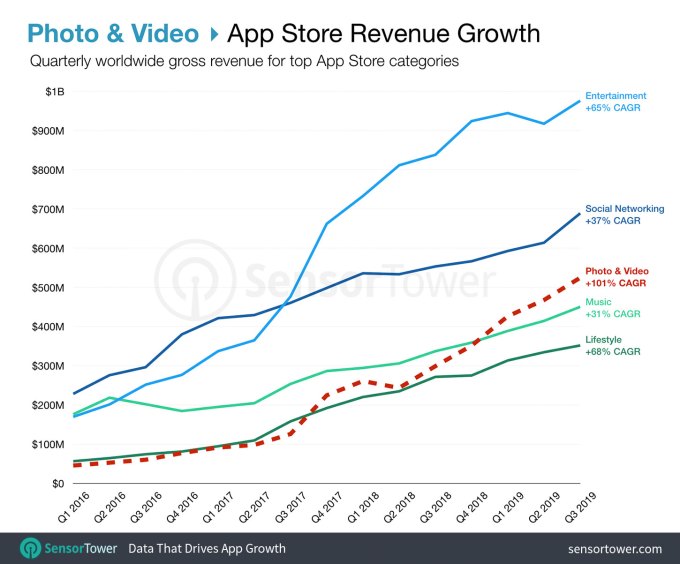
In Q3, the category grossed more than $500 million, up a whopping 75% year-over-year, says Sensor Tower. It’s also seeing an annual growth rate of 101% since 2016. Much of this is attributable to YouTube, which alone was responsible for 30% of the category’s revenue in Q3. (Just wait until TikTok takes in-app monetization seriously, though.)
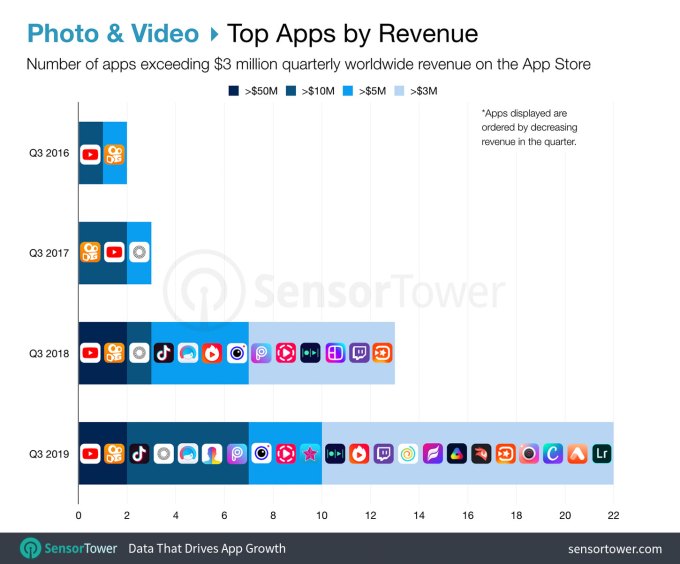
But now, it’s not just the top apps that are growing. In Q3, 22 apps exceeded $3 million in gross user spend, compared to just 2 in Q3 2016. And 7 apps had more than $10 million in revenue, including TikTok, VSCO, Facetune 2, FaceApp, and PicsArt.
How well is Apple Arcade doing? No one knows, but Apple says it’s great!
Apple Arcade is a black box — there’s no visibility into which apps are successful in this subscription-based area of the App Store due to a lack of top charts or even an API for app store intelligence firms to use for competitive insights. Instead, Arcade is like a Netflix for apps — Apple buys the rights to the app, and that’s it. (No, that’s really it, we heard. Email me if you know more: sarahp@techcrunch.com)
On Apple’s Q4 earnings call, investors were hoping to get a little more insight into Arcade’s traction, but Apple was fairly tight-lipped. CEO Tim Cook said it’s too early to talk about free trial conversions, but Apple was said it was pleased with sign-ups during the trial period.
“I feel like we’re off to a good start and most important of everything, the customer feedback to date has really been incredible,” said Cook. “And we’re very excited for the future of the service.”
Apple’s Services revenue, which includes the App Store, hits all-time high of $12.5B
Apple’s broad services category — which includes the App Store, Mac App Store, Apple Arcade, Apple Music, Apple Pay, AppleCare, and Apple News+ — hit an all-time high of $12.5B in fiscal Q4, reports MacRumors.
That’s up from $10.6 billion in the year-ago quarter, and $11.56 billion in Q3. Said Tim Cook:
This isn’t a local phenomenon. We saw double-digit services revenue growth and all-time records in all five of our geographic segments, and it wasn’t a narrow success either.
We established new all-time highs for multiple services categories including the App Store, AppleCare, Music, cloud services and our App Store search ad business. We are well on our way to accomplishing our goal of doubling our fiscal year ’16 Services revenue during 2020.
This is important for Apple because it means the company is learning how to extract more revenue from the devices it sells, rather than just relying on hardware sales to drive its business. And its latest service, Apple TV+, launched yesterday.
For App Store developers, one of the big contributions to the services revenue are the App Search Search Ads, which have increasingly become the way to get found as the store moved away from charts and rankings to drive consumer interest.
Google’s “Other Revenues,” which includes Play Store, hit $6.42 Billion
Like Apple, Google doesn’t break out its Play Store revenues directly. But it combines them with other business categories in a different way. The “Other Revenues” group, which includes hardware, Play Store and Google Cloud enterprise efforts, hits $6.42 billion in Q3 up from $4.6 billion in the same quarter last year.
Google won’t open up Motion Sense to third-party developers
Did you hear about the Pixel 4’s nifty new addition, Motion Sense? Now you can control the phone just by waving your hand over it, but without touching the screen. Okay, okay — it’s a bit gimmicky, but it’s a differentiator. Motion Sense, takes advantage of the new Soli chip in the phone, but it’s not open to the broader developer community.
Google confirmed to Android Police there’s no plan for a Motion Sense API for third-party developers at this time, but “we’ll let you know if plans change,” the company said.
For now, the feature works with two demo apps: Pokemon Wave Hello and Headed South (from ustwo, makers of Monument Valley).
Were you hit by the App Store Ratings Apocalypse?
A bug impacting the App Store wiped out over 20 million app ratings for a week. The issue extended from October 23 – 29 and impacted apps both large and small. Among those who felt the issue the most were Google, Microsoft, Amazon, Hulu, Starbucks, Chase, Walgreens, and others. Hulu even lost 95% of its ratings in the U.S.
Apple, uncharacteristically, admitted to the problem:
During routine maintenance to the App Store, ratings and reviews were temporarily affected by a bug that has since been resolved. While no reviews or ratings were ever deleted, the data displayed to users was impacted for a period of time. We apologize for the inconvenience this caused. All ratings and reviews have been restored.
Microsoft previews Xbox-to-Android streaming

Microsoft this week introduced the first preview of its Xbox streaming feature which lets you stream games from your Xbox One to your Android device. The preview is open to Xbox Insiders in the Alpha and Alpha Skip-Ahead rings in the U.S. and U.K.
Cross-platform gaming has been made more popular in recent years by way of hit titles like Fortnite and PUBG Mobile, as well as devices like the Nintendo Switch. App Annie in a June research report said cross-platform has attributed to mobile games reaching a 60% market share in consumer spend in 2019, for example.
But these were focused on taking mobile games to the big screen. Xbox Console Streaming goes the other way around — taking Xbox One games, including Xbox Game Pass titles, to your Android phone and tablet.
In the future, all your games will just follow you around your various platforms and this is one more step towards that.
Mobile Gaming trends in Q3 2019
Fun Race 3D from Good Job Games was the most downloaded mobile game in Q3 2019 with close to 123 million first-time installs, says Sensor Tower. Other top titles included PUBG Mobile from Tencent (94M installs) Mario Kart Tour from Nintendo, Aquapark.io from Voodoo, and Garena Free Fire from Garena.
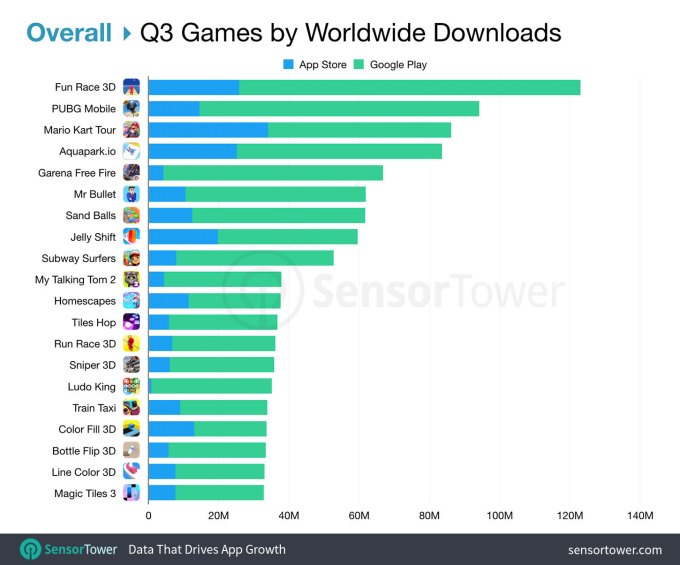
Mario Kart Tour raked in 123.9 million downloads in its first month, and Pokémon Go hit a milestone this quarter by topping $3 billion in lifetime revenue.
Meanwhile, App Annie estimates that mobile games accounted for 70% of the record $23 billion consumers spent across iOS and Android in Q3 2019. A huge majority of that comes from the free-to-play model. But Apple Arcade, Play Pass, and new startups like GameClub are looking towards subscriptions as a new way to monetize games.
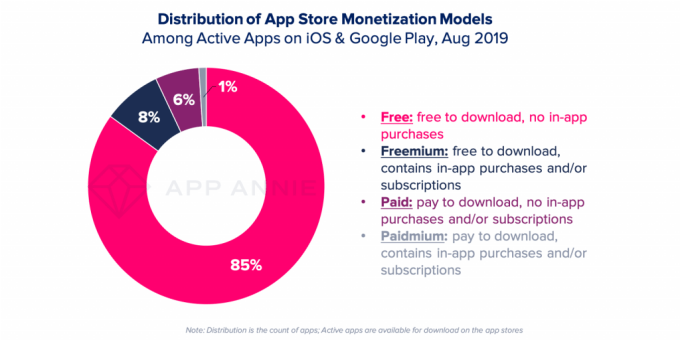
Samsung debuts “Bixby Views”
Samsung debuted Bixby Templates, reported VentureBeat, which allows for easier creation of voice apps. It also introduced Bixby Views for voice apps to work on things like televisions, smartwatches, tablets, and the Smart Hub refrigerator. Bixby Views will compete with rival visual-voice app experiences from Google Assistant and Alexa’s Visual Presentation Language, the latter which became generally available last month.
Sensor Tower’s new “Official Annotations” will explain what happened to an app
App store intelligence firm Sensor Tower this week announced a new feature called “Official Annotations” that aims to offer helpful insights around events in an app’s history. For example, some of the spikes in the HBO’s app history can be explained by the “Game of Thrones” premieres. Others, however, aren’t as easy to figure out. That’s where the annotations will come in.
The feature will include live operations announcements, content releases, and major news events that could affect the app’s performance, the firm says. These will appear as text comment icons along the bottom of the graphs on its site.
More Reading
Developer Concerns: Apple, Your Developer Documentation is…Missing
Developer Chris Krycho calls out Apple for having left numerous parts of its developer ecosystem entirely undocumented:
The current state of Apple’s software documentation is the worst I’ve ever seen for any framework anywhere.
Swift itself is relatively well covered (courtesy of the well-written and well-maintained book). But that’s where the good news ends.1 Most of SwiftUI is entirely undocumented — not even a single line explanation of what a given type or modifier does. Swift Package Manager has okay docs, but finding out the limits of what it can or can’t do from the official docs is difficult to impossible; I got my ground truth from Stack Overflow questions. I’ve repeatedly been reduced to searching through wwdc video transcripts to figure out where someone says something relevant to whatever I’m working on.2
He’s not the only one complaining. There’s even a tool called “No Overview Available,” which helps developers determined if the documentation they need just doesn’t exist.
When developers are spending their time building tools to point to missing documentation instead of actually developing software, you’ve got a problem, Apple.
Analysis: Everything is Amazon, But Nothing is Ours
Some food for thought for the app industry, given the shift to the subscription business model from paid downloads and one-off, in-app purchases. Former Social Capital associate Alex Danco writes about software’s shift from ownership to services — and the costs involved with that. He says the next big counter-trend could be “technology that’s actually yours.”
I think there’s a really strong, counter-trend bet to be made here over the next few tech generations. If the world is going to get reorganized into services and dependencies, so be it; but find what’s air gapped, and find what’s ours. People are smart enough to tell what’s solid and what isn’t. Product teams who go out of their way to give us real, tangible objects we feel that we can own will find a great deal of success.
Downloads
App of the Week: Adobe Creative Cloud
It’s not a new app, but it’s a notable update. On Friday, Adobe released an updated version of its Creative Cloud app for iOS which now includes a set of thousands of fonts that can be installed on iPhone and iPad devices by way of the new font provider system that launched with iOS 13. Once installed, these fonts can be used with any other app that supports custom fonts. MacStories has the how-to guide on this new resource.
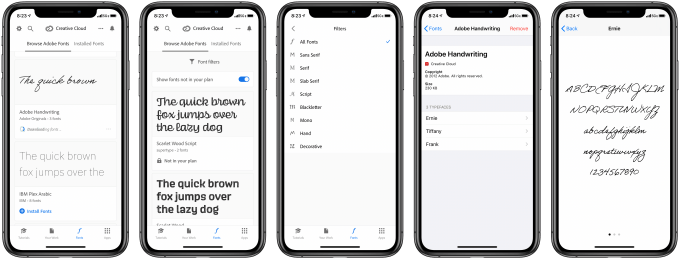
Game of the Week: Magic Brick Wars
Australian developer Halfbrick Studios, the creators of Fruit Ninja and Jetpack Joyride, is back with a new game. After a three-year hiatus, it’s released a real-time multiplayer strategy game called Magic Brick Wars. Now everyone is waiting to see if the developer will have another hit on its hands. The title is live in the U.K., and launching everywhere else on Nov. 15. (So switch your App Store location and get it now).
Tweet of the Week
A nice little resource for Swift devs, announced by way of a tweet: